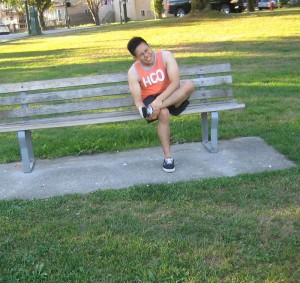It is important to note that a calf strain involves a tear to one or both of the muscles at the rear part of the lower leg. As a common injury during sports, it is important that you are ready to manage this injury. To learn to recognize, manage and help individuals with muscle injuries including a calf strain, enroll in a first aid course today.
What are the symptoms?
The signs and symptoms of a calf strain tend to vary considerably but generally include abrupt piercing soreness at the rear part of the inferior leg. Remember that the calf muscle is usually tender at the area of injury that can be accompanied by bruising and swelling.
Depending on the severity of the calf strain, the individual might be able to carry on with a certain degree of discomfort or finds it difficult to walk due to the intense pain. Calf strains are categorized as 1, 2 or 3 depending on their severity. Take note that grade 3 is the most painful and severe.

Treatment
It is important to use the RICE method that must be applied as soon as possible to help stop any internal bleeding. An ice pack can be applied for 10-15 minutes every hour primarily and eventually decreasing the rate as the swelling and pain subsides.
Utilize a compression bandage or a calf sleeve or support. The compression bandage can be applied right away to stop the swelling but must be applied for 10 minutes at a time since it can disrupt with the flow of blood to the tissues which can lead to more damage.
The individual should also use a heel pad to elevate the heel and shorten the calf muscle, thus taking off some of the strain on it. It is also recommended to use heel pads in both shoes or one leg will appear longer than the other, thus creating an imbalance and even leading to other injuries including back injuries.
A sports injury professional can be consulted to start the appropriate rehabilitation program for the calf strain along with strengthening and stretching exercises.
Treatment for calf strain
The doctor will prescribe anti-inflammatory medications which is useful during the first few days after the injury. Just remember that ibuprofen should not be given to those who have asthma.
Electrotherapy such as ultrasound therapy can be used. During the early stages, this can help with pain relief to minimize the swelling. In the later stages, micro massage can help stimulate the flow of blood to the muscle.
Sports massage techniques for the calf muscles are performed after the initial acute phase. Sports massage works by stimulating the flow of blood, stretching the muscle and loosening any tightened knots, bumps and lumps in the muscle. Take note that scar tissues are softened and new fibers aligned which help with the healing process and aid with re-injury.
It is also prescribed to start a full rehabilitation program with stretching and strengthening exercises focused on the calf. Once initial healing has taken place, it is vital that the lower leg is fully strengthened to reduce the risk that the injury will reoccur or have an adverse effect in the future.
